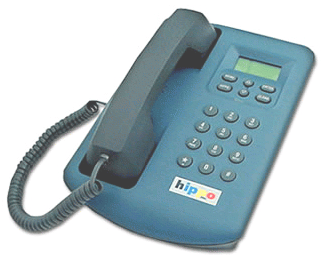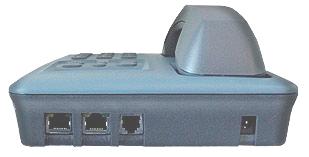Article: Device Profile: hippo Internet Phone
May 7, 2002 — by LinuxDevices Staff — from the LinuxDevices Archive — 7 viewshippo inc. (New Haven, CT) has introduced a line of voice-over-IP (VoIP) based “Internet Phones”, which use Embedded Linux as their internal software platform.
What's an Internet Phone?
hippo's Internet Phone looks a lot like an ordinary desktop telephone, but can make calls over either Ethernet LAN or normal telephone lines (via PPP, through the user's local ISP). Instead of being carried as analog signals over normal phone lines, the calls are carried digitally, over the Internet. At the other end, the calls can be received by either another Internet Phone (PC-based, or dedicated Internet Phones) or by a standard “PSTN” (Public Switched Telephone Network) telephone anywhere in the world (including cell phones). Obviously, substantial reductions in phone bills are possible using this approach, since no long distance phone calls are necessary.

The hippo300 Internet phone
Here's how it works: The user initiates a call from the hippo Internet Phone via either its Ethernet port or dial-up modem. Internet access is established through the user's ISP. Once the connection is established, the Internet Phone converts the user's voice into data packets which are transmitted over the Internet, and similarly converts received data packets into sound presented to the phone handset earpiece. The reverse process occurs at another Internet phone on the other end of the connection, or at a VoIP-to-PSTN gateway (such as the service offered by Net2Phone) if the other end of the connection is a standard (PSTN) phone.
The hippo Internet Phone has a 4×20 character LCD screen, a 12-button telephone keypad, 6 function keys, and a telephone handset with hook/switch, ringer, and normal-sounding dial and call progress tones which simulate “normal” telephone operation.
According to hippo's documentation, setup of the device is easy. All that is necessary is to plug it into an electrical outlet, an Ethernet connection, and (for models which support it) a telephone connection — and dial!

Rear of hippo300, showing Ethernet, PSTN, and power connectors
What's inside the Internet phone?
The heart of the hippo Internet Phone is an embedded computer based on a 48MHz Motorola MPC850/823 PowerPC system-on-chip processor, equipped with 16MB of DRAM memory. The model 200E and 250E each have a single Ethernet connector, while the model 300E has a built-in hub which provides two Ethernet connectors, allowing users to share an Ethernet connection between a hippo Internet Phone and a PC without additional external hardware.
An optional “EP” version of each phone model (200/250/300) adds a built-in modem and an associated external RJ11 connector, which lets users make VoIP calls over a standard analog phone line (using an available ISP) as an alternative to the Ethernet connection. In addition, the 300EP can make and receive standard phone calls as well. The company has also developed a version of the Internet Phone with a PCMCIA port that offers the flexibility of using wired or wireless PCMCIA interfaces — including HomeRF 1.0, IEEE 802.11b, or (wired) Ethernet — however, this model is not currently offered as a standard product.
As mentioned earlier, hippo uses Linux as the embedded operating system in their phones. According to Ritha Pai, hippo's Chief Technology Officer, hippo's Internet Phones currently use Linux kernel 2.2.13/2.2.14 and a migration to the 2.4.x kernel is in process.
Pai says hippo's software developers started out with downloaded “community” PowerPC Linux sources, but decided to move to MontaVista Software's Hard Hat Linux in order to avoid the need to deal with library mismatches and other issues associated with not starting from a prequalified Embedded Linux distribution.
Why Embedded Linux?
“Embedded Linux saved us,” says hippo CEO Fred Whitridge. hippo initially licensed the Helios operating system from Perihelion (a UK company), which ran on a Cirrus ARM7 processor that served as the original system platform. But right around that time, Cirrus was hit with major financial problems (later cured by their successful audio chip business) which caused a repositioning of their product line — with the result that hippo found themselves looking for a new hardware/software platform, and $12,000 in the hole.
Next, they switched to the Motorola PowerPC platform and, after what they thought was an exhaustive investigation of alternatives, settled on Wind River's pSOS embedded OS. “Shortly after we purchased a Motorola 'FADS board' for the PowerPC,” recalls Whitridge, “we found out that pSOS had never been brought up on the board — at least not to our satisfaction. We went thru round after round of questions and lame answers: 'Oh, you want to use both serial ports?' . . . 'Oh, you need an IP stack?' . . .”
“In the process of trying to bring up pSOS on the FADS board ourselves, we called every consultant listed on the pSOS web page,” Whitridge explains. Finally, hippo found someone who claimed he made his living providing support for pSOS implementations on new platforms. That resulted in what Whitridge describes as “a $35,000 mistake.” They were now $47,000 down, and still without a working platform.
“In desperation we began looking around for single board computers based on the PowerPC and running Linux,” says Whitridge. And then came the breakthrough. “We found the wonderful IPengine from BrightStar Engineering and its helpful principal, Stuart Adams. Within a week we had the box doing primitive one way calling. Stuart and Brightstar quickly took us right to the prototype of the basic architecture we run today.”
“Embedded Linux worked like a charm, and with a bit of tinkering has continued to serve us well,” adds Whitridge.
Some software challenges
The Embedded Linux based software development process was not without its challenges. “We needed to work around the fact that Linux is not a real-time operating system,” observes Pai. “But because we use a DSP as the audio processing engine, we were able to reduce the real-time requirements imposed on the PowerPC running Linux. We architected the software to ensure that the processes responsible for handling the audio packets were given the highest priority.”
Also, Linux needed a larger memory footprint than the embedded OSes that had been previously considered. “We have not embarked on aggressive memory footprint reduction projects, but expect to do so with the new tools available that pare down the libaries and other utilities,” Pai adds.
In any case, Pai believes the increased resource demands of Linux are worth it. “Even though the footprint is larger, the increased flexibility and the absence of royalties more than make up for the increased memory size required,” she says.
According to Pai, the team was able to get their wireless phone prototype running and making VOIP calls “within three weeks of receiving the hardware — primarily because we could leverage the existence of card services and Linux drivers for the PCMCIA cards we were using”.
“We don't think we could have achieved the same results in that short a timeframe with any other OS,” comments Pai. “Being able to leverage the work of the Linux development community, including the availability of source code, made it much easier and quicker to create a prototype and bring up new features. We could not have done the project so quickly or with the resources at our disposal otherwise.”
On the other hand, Pai notes that “Linux is still primarily Intel processor oriented — even though MontaVista and others have made huge strides with PowerPC/Linux, it's still not as mature as Intel/Linux.” Pai also would like Embedded Linux to be able to boot more quickly on the devices.
Future plans
hippo was founded in June, 1998 under the name PDA Peripherals Inc. The initial plan was to add VoIP capabilities to a wide range of products, in addition to creating VoIP-based standalone Internet Phones. Some examples of applications where hippo's VoIP hardware and software are being used include a sidewalk kiosk, a LAN-based PBX, and a web tablet.
hippo's business model is to sell Internet Phones but also to offer services, such as terminating Internet phone calls on the standard PSTN phone network. Accordingly, hippo has arrangements in place which allow them to offer the use of Net2Phone's protocol, network, and gateway services. Other such services will be offered soon, says Whitridge.
hippo has been granted a US Patent for VoIP on handheld devices and PDAs, and is currently working with several PDA manufacturers who are interested in incorporating VoIP telephony into their PDAs. “We think VoIP on a PDA — eliminating the need to carry both a cell phone and PDA — would be very cool, and ought to be cheaper to acquire and operate than the wide area solutions such as the Kyocera PDA/CellPhone or the VisorPhone,” says Whitridge.
When can I get one, and how much will it cost me?
The hippo 300EP Internet Phone (including both an Ethernet interface and a dial-up modem) is available now for $279 from hippo's website. Other models with reduced feature set are also available for lower prices.
This article was originally published on LinuxDevices.com and has been donated to the open source community by QuinStreet Inc. Please visit LinuxToday.com for up-to-date news and articles about Linux and open source.